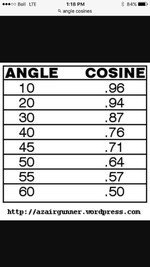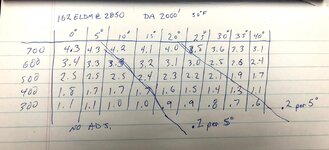Little Tunny
FNG
For someone who uses a ballistics app and dope cards, and only has a basic rangefinder, how do you deal with angle compensation at longer ranges? I use Shooter and have a couple of cards for varying density altitudes I'm likely to see on a particular hunt. With a mil/mil scope and familiarity with the range of adjustments for varying DAs, it's all fairly easy for me to keep straight in my head (this forum is responsible for converting me to mil/mil, btw, which has been a game changer).
But I guess my fundamental question is: at what range does the angle adjusted range from a relatively cheap rangefinder, like my Sig Kilo 2200, start to screw up the Shooter App solution enough to worry about? I think the Sig manual says something about how it's good to around 400yds, but not sure why or what they are referring to. I understand time of flight starts to become a factor, which would change the wind calls. But for a guy that's trying to hit a deer-sized target at 6-700yds max, does the angle compensated range get me close enough for dialing a correct elevation at those distances?
Unfortunately, I live in the flatlands so can't easily true up steep-angled shots with my particular rangefinder, which would quickly answer my question. Or maybe the answer is, you need to spend $1,200 on a Revic, or use LOS with angle and deal with a more cluttered dope card (e.g., 700yds: -.3@20degrees; -.7@30degrees, etc.). If the angle adjusted range from my rangefinder is garbage, is there a simple, easy to remember analog shortcut similar to wind brackets that will get me in the vitals at 6-700yds? What did folks do 20 years ago?
But I guess my fundamental question is: at what range does the angle adjusted range from a relatively cheap rangefinder, like my Sig Kilo 2200, start to screw up the Shooter App solution enough to worry about? I think the Sig manual says something about how it's good to around 400yds, but not sure why or what they are referring to. I understand time of flight starts to become a factor, which would change the wind calls. But for a guy that's trying to hit a deer-sized target at 6-700yds max, does the angle compensated range get me close enough for dialing a correct elevation at those distances?
Unfortunately, I live in the flatlands so can't easily true up steep-angled shots with my particular rangefinder, which would quickly answer my question. Or maybe the answer is, you need to spend $1,200 on a Revic, or use LOS with angle and deal with a more cluttered dope card (e.g., 700yds: -.3@20degrees; -.7@30degrees, etc.). If the angle adjusted range from my rangefinder is garbage, is there a simple, easy to remember analog shortcut similar to wind brackets that will get me in the vitals at 6-700yds? What did folks do 20 years ago?


